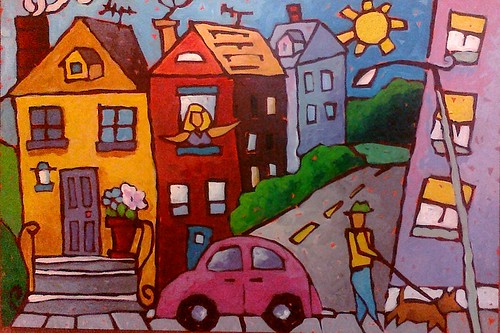 What would a community-wide capacity building initiative look like if it aimed not at organizational capacity but at community capacity? And what would it take to make that so?
What would a community-wide capacity building initiative look like if it aimed not at organizational capacity but at community capacity? And what would it take to make that so?
These are the questions a group of us gathered to explore in late August, towards the end goal of a possible demonstration project – a proof of concept for enhancing the capacity of a whole region to respond to whatever circumstances arise. This blog post is a summary of that 2-day conversation, and an invitation to explore along with us!
Background
Westmoreland County is a rural county in southwestern Pennsylvania, where the Westmoreland County Community Foundation started a small capacity building initiative over the past few years. The foundation brought together their colleagues from several other regional and statewide capacity building organizations, to explore what is possible from their various perspectives.
As a living laboratory, Creating the Future‘s focus is on enhancing the capacity of each and every one of us to be the world we want to see. Creating the Future’s interest in this possible demonstration project is to prove that our frameworks and approaches – which have heretofore been successful in shifting paradigms in one organization at a time – can create more sweeping improvement when focused on whole communities vs. individual orgs.
 The Format for the Discussion
The Format for the Discussion
The group used Creating the Future’s framework to frame the discussion:
- Reach for the highest potential outcome possible as our vision for success
- Establish the cause-and-effect path of favorable conditions that would create that outcome
- Identify possible action steps aimed at establishing those favorable conditions
- Be sure those action steps walk the talk of / reflect the conditions we want to create / the values and behaviors we want to see in others.
In addition to sharing the conversation around each of these steps, the following summary includes the questions we asked (to help others follow this same framework towards their own successes!).
The Vision for Success
The Question: What would our community look like if a capacity building initiative were 100% successful?
The group quickly found resonance in this response:
Communities will have the capacity to organize organically to effectively address needs and opportunities that arise.
Individuals and groups in communities will have the capacity to create the future they want to see, working with each other (vs. for each other), each participating with who they are and what they have (a spirit of Stone Soup).
The Path of Causality
Question: What will it take for that vision to be reality?
Relationships, connections, conversations. People coming together for a purpose. Each bringing who they are and what they have, in a spirit of “with” vs. “for.”
– Community with community
– Organizations with individuals
– Orgs with each other
– “Entities” blurring sector and silo lines (orgs / business / government)
– Funders with organizations
Question: What will it take for people to come together for a common purpose?
The group identified three major categories of pre-conditions for people to routinely and easily gather together:
1) A culture of coming together as the natural go-to option
2) Mechanisms for people to come together
3) Skills for coming together effectively and naturally
 Pre-Condition for Success: Creating Culture of Coming Together
Pre-Condition for Success: Creating Culture of Coming Together
The first set of pre-conditions the group discussed, to pave the way for people to routinely and easily gather together for a common purpose, had to do with creating a culture of coming together:
Question: What will it take to create that culture?
• Leadership / Early adopters who will model / walk the talk
• Trust – community members will need to trust each other
Question: What will it take to create trust?
• Communication / conversation
• Stepping outside assumptions & judgments about other people’s motivations
Question: What allows us to step outside those assumptions and judgments?
• Conversation
• Commitment to model / demonstrate that it is possible.
• Addressing issues re: power and money (important for funders and orgs, but also orgs and individuals / communities they serve)
Question: What will it take to address / change issues of power and money in relationships
• Reframing language – for example, from “language of requirements” to “language of shared values and vision; language of agreement; language of “we” vs. “you / I”
• Eliminate the scarcity mentality
Question: What will it take to eliminate the scarcity mentality?
• Evidence – a “lighthouse” as a beacon for what’s possible (models, examples, leadership)
• Shared understanding that the community has sufficient resources (Individually we may not have enough; collectively we have all we need)
Question: What will it take to create the understanding that there is enough?
• Models to demonstrate what it looks like to identify “abundant” resources and build upon them
• Leaders redefining success as community success vs. org success
• Rituals, traditions, “this is how we do things,” systems (e.g. recruiting – based on who someone is as a person vs. what they do / their position)
Pre-condition for Success: Mechanisms for People to Come Together
The second set of pre-conditions the group discussed, to pave the way for people to routinely and easily gather together, had to do with having programs and mechanisms for doing so:
Question: What will the community need to have in place for people to routinely and easily gather together for a common purpose?
• Places to gather
• “Programs” (loosely defined) with the primary purpose of bringing people together
• People with skills for convening
Pre-condition for Success: Skills for Coming Together Effectively and Naturally
The third set of pre-conditions the group discussed, to pave the way for people to routinely and easily gather together for a common purpose, stemmed from the systems and mechanisms noted above – skills for effective convening towards visionary ends.
Question: What will it take for community members to have the skills to gather together effectively towards a common purpose?
• Individual community members have skills on their own, just as how they live their lives
• Professionals have those skills (see mechanisms above)
• Capacity Building efforts that aim at community strength vs. org strength
Identifying Possible Action Steps
The participants in this extended conversation covered a lot of ground in a short amount of time. Several categories of ideas arose, and those will be the stepping off point for future conversations.
An Event
Bringing together community leaders for a day-long event that introduces a new way of thinking and invites a new conversation – both right then and there AND afterwards.
Conversations
Conversation was such a critical condition for success – participants got excited about conversation in a variety of realms (including the event noted above!). There is the power of beginning one-on-one sleuthing conversations immediately, with coworkers and colleagues, to explore what it might mean to aim capacity building at community strength vs org strength. And then there is the power of having those same conversations in group settings. Those conversations could occur before an event, during an event, after an event – or instead of an event!
Training
Lastly, the need for training was raised again and again. Obviously, an event would be all about training, and would likely require training of facilitators to convene that large group conversation. Then there was discussion of the need for people who are trained to immediately help people after the event, so those individuals could keep their momentum going forward.
There was also discussion of the need for training in how to have the many conversations noted above. The group was struck by a notion that is at the core of Creating the Future’s work – that when a group uses effective questions, then everyone becomes the “right people” at the table / on the bus. That being said, what are those effective questions? How does one facilitate conversations that bring out the individual wisdom of everyone in the room, while bringing out the collective wisdom of the group – regardless of who is in the room?
The Group’s Commitments
Given everyone’s existing commitments prior to entering this conversation, it will take some time to determine how we might proceed – and how to fit any activities into existing calendars and activities by these busy people. That said, there were two commitments we all felt we could do immediately:
1) We will all be as conscious as possible to model this vision and these pre-conditions for success, in the work of each of our organizations. We will aim to have peer conversations vs. power conversations. We will aim to engage conversations to build trust. We will aim to build programs and other efforts “with” others, vs. “for” others. And we will aim to build every effort, regardless of how small or large, by first identifying existing assets (physical, mission, human, community) upon which we can build.
2) We will continue our conversations, to see what’s next for this possible demonstration project of what is possible.
This was an auspicious start. And it leads us to ask you, as someone who cares about the capacity of your own community: Of everything we have shared here, what stands out for you? What resonates? And what has been your experience, in similar circumstances, where communities have built their capacity to be the future they want to see? What favorable conditions have you found it takes, to turn great ideas into community-wide action?
We hope you will share your own wisdom and experience right here!

1 thought on “Building Community Capacity”